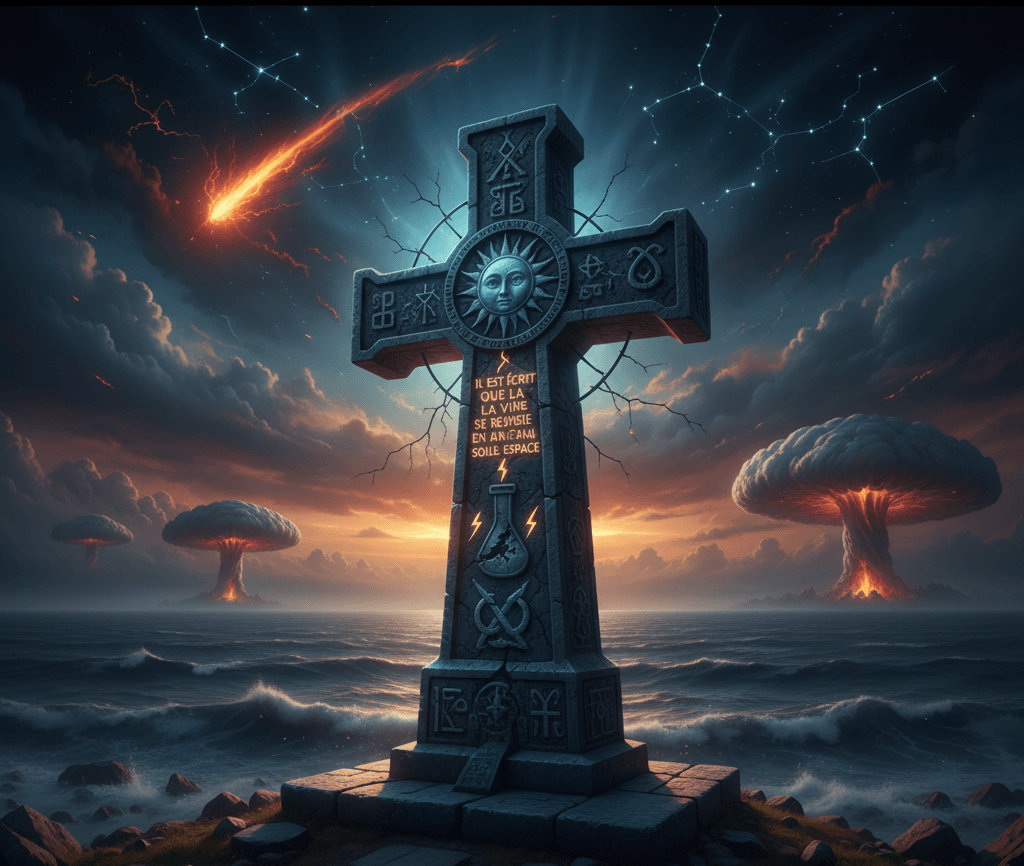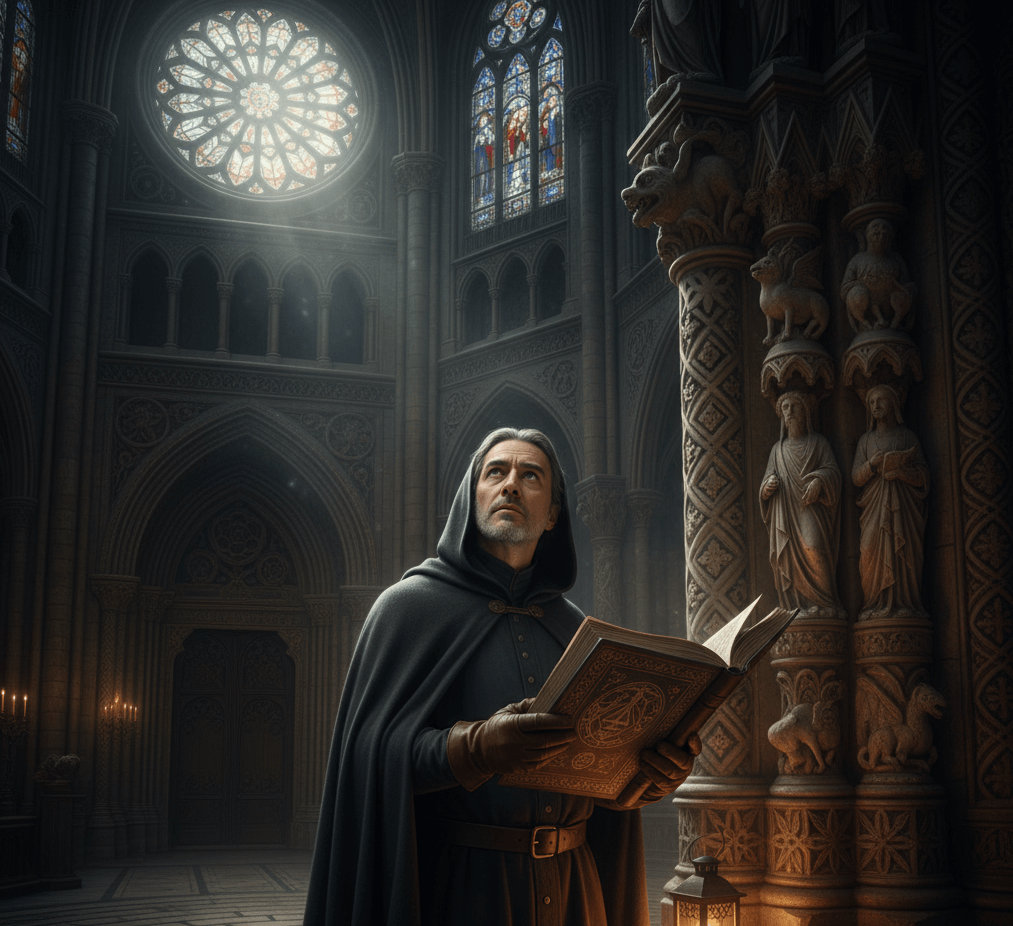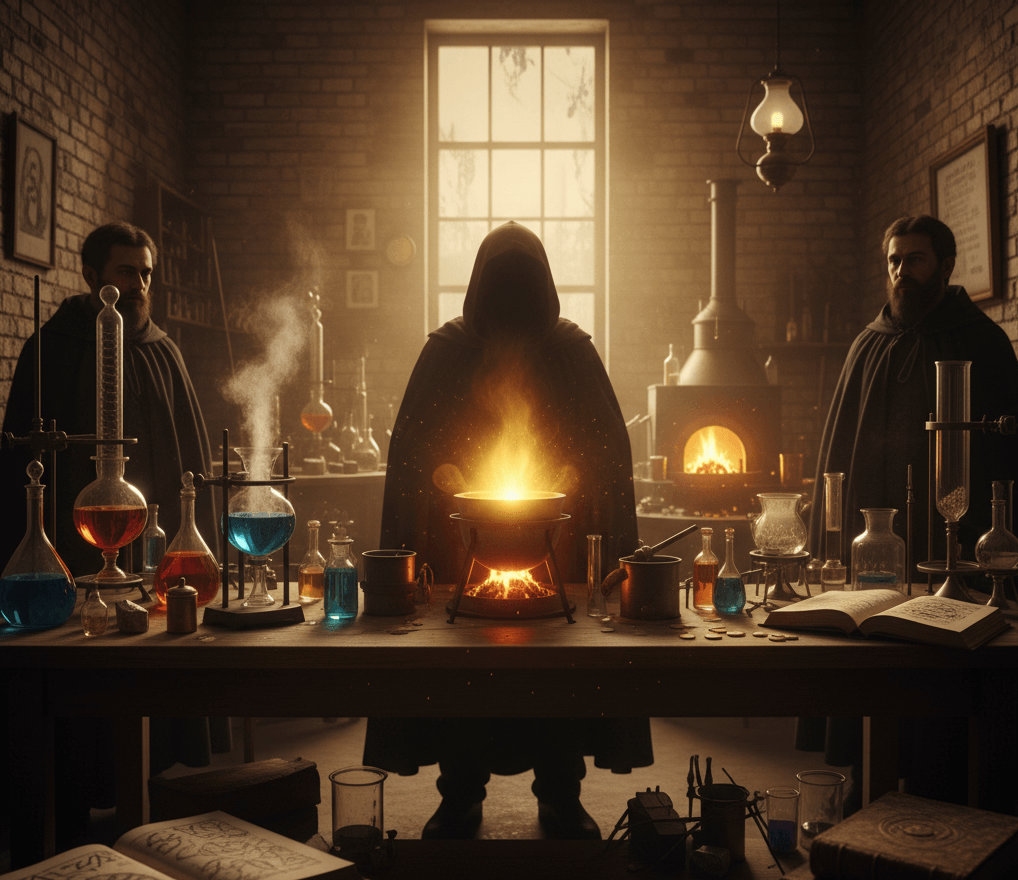Introduction: The Last Great Alchemist
In the dark world of 20th-century esotericism, few people are as interesting as Fulcanelli, the mysterious French alchemist whose name is known in both academic circles and occult legend. Fulcanelli, who was called "the last of the great alchemists," was briefly part of Parisian intellectual circles in the 1920s. He left behind two amazing books and then disappeared completely, leaving behind only rumors of immortality and change.
The name itself, which is a mix of Vulcan, the Roman god of fire, and El, the Canaanite name for God, hints at the "Sacred Fire" that is at the heart of alchemical change. Fulcanelli was not like the many charlatans and fraudsters who used to hang out in the occult underground. He was very knowledgeable about architecture, chemistry, linguistics, and hermetic philosophy, and researchers are still amazed by his work almost a hundred years later.
Fulcanelli is different from other mysterious people not only because he vanished, but also because he made the amazing claim that he completed the Great Work, which is the alchemical change that gives both material transmutation and bodily immortality. Eugène Canseliet, one of Fulcanelli's students, said that Fulcanelli showed up decades after he was supposed to be dead, looking much younger and saying he had learned the secrets hidden in Gothic stone.

The Mysterious Manuscripts: Le Mystère des Cathédrales
Fulcanelli is best known for two amazing books: "Le Mystère des Cathédrales" (The Mystery of the Cathedrals), which came out in 1926, and "Les Demeures Philosophales" (The Dwellings of the Philosophers), which came out in 1930. These books, especially the first one, changed how people thought about Gothic architecture as a place to store alchemical knowledge.
In "Le Mystère des Cathédrales," Fulcanelli contended that Gothic cathedrals, particularly Notre Dame de Paris, were not solely Christian edifices but intricate alchemical manuals inscribed in stone. People say that every gargoyle, bas-relief, and architectural detail had coded instructions for the Great Work that had been hidden in plain sight for hundreds of years. The book's subtitle, "Esoteric Interpretation of the Hermetic Symbols of the Great Work," shows how big it is.
Fulcanelli said that medieval alchemists met every Saturday at Notre Dame and that the cathedrals used to be covered in gold and bright colors that made their alchemical meanings stand out. He said that the word "Gothic" came from the old French word "goetic," which means "magical." He said that Gothic art was really magic art made to change people's spirits.
Jean-Julien Champagne illustrated the manuscripts with detailed engravings that showed the exact alchemical symbols that Fulcanelli said he could decode. These pictures were not just for decoration; they were necessary to understand the supposed hermetic messages hidden in the stone.
Theories of Identity: Who Was Fulcanelli?
Many theories have been put forward about Fulcanelli's true identity, and each one is more interesting than the last. No one in his close circle, called Les Frères d'Héliopolis (Brothers of Heliopolis), ever said they had met him in person. They only said he was "a man of respectable age, distinguished, wealthy, and very cultivated."
Some researchers suggest that Fulcanelli was a descendant of the House of Valois, a royal family known for their interest in magic for a long time. This theory posits that alchemical secrets pertaining to rejuvenation and longevity were transmitted across generations, ultimately materializing in the 20th century via Fulcanelli. The link between Marguerite de Valois, Francis Bacon, and the Rosicrucians gives this theory more historical weight.
Patrick Rivière, a student of Canseliet, recognized Fulcanelli as Jules Violle, a renowned French physicist. This theory is more believable because Fulcanelli's works show a deep understanding of atomic theory, especially his prophetic warnings about nuclear weapons decades before Hiroshima.
The most contentious theory posits that Fulcanelli was, in fact, Jean-Julien Champagne, the illustrator, potentially collaborating with others. Champagne, a well-known prankster, died in 1932 from gangrene poisoning. Some people say this proves the theory wrong, while others say it was staged.
Recent studies suggest that there may be a link to the Gallatin family, who were among the founding fathers of the United States. A rare French alchemical manuscript associated with Fulcanelli was discovered in the New York Public Library's collection, having come from Albert H. Gallatin, a chemistry professor dedicated to the study of ancient alchemical writings.

The Transmutation Stories and Eugène Canseliet
The most remarkable assertions regarding Fulcanelli pertain to genuine transmutations-the transformation of base metals into gold. Eugène Canseliet, Fulcanelli's most devoted student, says that two documented transmutations happened in controlled settings.
The first transmutation is said to have happened in 1922 at the Sarcelles gas works laboratory. Canseliet, Julien Champagne, and Gaston Sauvage all saw Fulcanelli turn 100 grams of lead into gold with a small amount of "Projection Powder," which is also known as the Philosopher's Stone. The setting-a municipal gasworks-makes an otherwise unbelievable claim seem more real.
In 1937, Fulcanelli allegedly turned 225 grams of lead into gold and 100 grams of silver into uranium at the Château de Léré. This was witnessed by chemists, physicists, and geologists. The production of uranium, especially important in light of later nuclear advancements, indicates either authentic alchemical success or extraordinary foresight.
Canseliet's own efforts to reproduce these changes were not as successful. In 1938, he said that a "small sun" rose from his furnace and went through the ceiling, with dogs barking in the neighborhood and huge northern lights visible all over Europe. In 1951, there were more failures like this, but Canseliet kept writing alchemical works until he died in 1982.
The most disturbing part of Canseliet's testimony is when he says he met Fulcanelli in 1954, twenty-eight years after the master went missing. Canseliet says that Fulcanelli looked younger because he had gone through the alchemical change that gives both wealth and long life.
Alchemical Meaning in Gothic Architecture
Fulcanelli's view of Gothic cathedrals as alchemical codebooks is one of the most advanced attempts to figure out what architectural symbols mean in Western esotericism. He concentrated his examination on Notre Dame de Paris, where he discerned numerous bas-reliefs featuring alchemical directives.
Fulcanelli's system says that the cathedral is like a huge crucible, with the cross being the alchemical symbol for the container where matter "dies" to be "revived, purified, spiritualized, and transformed." The pointed Phrygian cap on the 12th-century alchemist statue on Notre Dame's north tower shows that he is an initiate who will always be watching over Paris.
Fulcanelli pointed out that there were no images of crucifixion in 12th-century cathedrals. He said that these buildings were more like temples to life than monuments to death. This interpretation is in line with alchemical philosophy, which sees death as a change rather than an end. The bright colors and gold leaf that used to decorate these buildings would have made their alchemical meaning stand out even more, but after hundreds of years of weathering, they lost their effect.
In Fulcanelli's system, the architectural parts have their own alchemical meanings. Rose windows stand for the philosophical rose, labyrinths stand for the long, winding road of change, and different animal designs stand for different parts of the Great Work. This symbolic language, called the "Green Language" or "Language of the Birds," was said to teach secret knowledge to people who were ready to learn it.
Contemporary scholars of sacred geometry have identified significant mathematical correlations in Gothic proportions that corroborate certain observations made by Fulcanelli; however, few endorse his particular alchemical interpretations.
The Hendaye Cross and the Prophecy of Nuclear War
Fulcanelli's most prophetic work may be his study of the Cross of Hendaye, a mysterious monument in southwestern France that he said held warnings about future global disasters. This analysis, included in later editions of "Le Mystère des Cathédrales," shows either amazing foresight or access to advanced scientific knowledge.
Fulcanelli did not see the Latin inscription on the cross as "O Cross, Our Only Hope." Instead, he saw it as a code that said "Il est écrit que la vie se réfugie en un seul espace" (It is written that life takes refuge in a single space). This cryptic message supposedly points to a place where people can escape the "double catastrophe" that the monument says will happen.
The "double catastrophe" includes both cosmic and earthly elements, such as the cycles of the universe and the ability of humans to use nuclear weapons. Fulcanelli's interpretation of INRI as "Igne Natura Renovatur Integra" (By fire nature is renewed whole) clearly says that "our hemisphere will soon be tried" by fire. This prophecy, written in the 1920s, seems very prescient, even though nuclear weapons didn't exist yet.

Fulcanelli's examination links alchemical processes to atomic structure, implying that conventional alchemists comprehended nuclear principles symbolically rather than literally. His warning that people would "literalize" the hermetic tradition by splitting atoms is eerily accurate. The connection between changes in the inner alchemical world and changes in the outer nuclear world suggests either real esoteric knowledge or amazing scientific intuition.
Modern researchers have discovered astronomical correlations within the Hendaye Cross that correspond with Fulcanelli's interpretations, especially concerning galactic cycles and their possible impacts on Earth. There is still a lot of debate about whether this is ancient wisdom carved into stone or advanced knowledge from the 20th century.
The Brotherhood of Heliopolis and What Happened to Them
Les Frères d'Héliopolis (Brothers of Heliopolis) was Fulcanelli's circle. It included some of the most interesting esoteric people in Paris in the early 20th century. People who were interested in both practical alchemy and theoretical hermeticism joined the group, in addition to Canseliet and Champagne.
The brotherhood was so secretive that no one ever said they had met Fulcanelli in person; instead, they got instructions through other people or written messages. This intentional vagueness has led to years of debate about whether Fulcanelli was a real person or a group identity.
After finishing his second book in 1930, Fulcanelli supposedly told Canseliet to destroy the manuscript of a third book called "Finis Gloriae Mundi" (The End of Worldly Glory) because he thought the information was too dangerous to be made public. If this decision is real, it shows either a lot of responsibility or a very complicated theatrical gesture.
After 1930, Fulcanelli stopped talking to his students, but Canseliet's claim that he saw him in 1954 suggests that he might still be alive. The master's last words reportedly stressed the dangers of nuclear technology and the need for spiritual readiness.
The brotherhood had an impact on more than just Fulcanelli's close friends and family. It inspired later generations of alchemical researchers and helped bring hermetic studies back to life in the 20th century. Contemporary alchemical organizations persist in the examination of Fulcanelli's writings, although none assert a direct descent from the original brotherhood.
Historical Context: Alchemy from Old to New
To comprehend Fulcanelli's importance, it is essential to understand the evolution of alchemy from ancient metallurgy to contemporary esotericism. Hellenistic Egypt was the birthplace of the Western alchemical tradition. It combined Greek philosophy, Egyptian temple wisdom, and early Christian mysticism. The legendary "thrice-great" founder Hermes Trismegistus is said to have combined the wisdom of the Egyptian god Thoth with Greek hermetic philosophy.
The Emerald Tablet, which is said to have been written by Hermes, became the most important book in alchemy because of its famous saying: "As above, so below, to perform the miracles of the one thing." This idea that the macrocosm and microcosm are related is the basis for all alchemical theories, including Fulcanelli's architectural interpretations.
During Europe's Dark Ages, Islamic scholars in the Middle Ages kept and built on alchemical knowledge. They added math and experimental methods to it. When these texts made their way to medieval Europe through Latin translations, they sparked a new interest in alchemy that led to people like Nicolas Flamel, a 14th-century Parisian scribe who is said to have done the Great Work.
The Renaissance revived interest in hermetic philosophy, with scholars such as Paracelsus enhancing both alchemical theory and practical medicine. Historians now know that alchemy helped early chemistry, physics, and psychology, even though the Scientific Revolution is said to have ended its credibility.
Modern nuclear physics ironically supports some alchemical ideas. For example, atomic transmutation is now a common scientific practice, but it is done in ways that traditional alchemy did not expect. This convergence supports Fulcanelli's prophetic warnings about nuclear technology.
Old and New Ways of Looking at It
Fulcanelli's impact transcends conventional alchemical domains, motivating artists, authors, psychologists, and even scientists. Carl Jung's analytical psychology extensively utilizes alchemical symbolism, interpreting the Great Work as a metaphor for psychological individuation-the synthesis of conscious and unconscious facets of personality.
Contemporary practitioners regard Fulcanelli's architectural analysis as indicative of the enduring significance of sacred geometry in comprehending consciousness and reality. Computer analysis of Gothic proportions uncovers mathematical relationships that corroborate certain observations made by Fulcanelli, although purely alchemical interpretations continue to be contentious.
Fulcanelli's warnings about how people tend to take spiritual metaphors literally have become more important since the nuclear age. His prediction that atomic power would bring both unprecedented opportunity and existential danger is remarkably accurate.
Modern alchemical studies prioritize psychological and spiritual transformation over physical transmutation, inspired by Jung's perspective of alchemical processes as frameworks for inner development. Nonetheless, certain researchers persist in examining the physical dimensions of alchemy, especially the interplay between consciousness and matter.
Fulcanelli's disappearance continues to inspire fictional works, including fantasy novels and conspiracy theories that link him to secret societies and government projects. These well-known interpretations often hide the complex research that went into his real works.
Conclusion: Truth, Immortality, and Mystery
Fulcanelli is still a mystery almost a hundred years after he went missing. Whether a true alchemical expert, a learned scholar, or a complex hoax, his works show a level of knowledge that goes against what most people think about history, science, and spirituality.
The question of Fulcanelli's identity may be less significant than the concepts he advocated-that ancient wisdom traditions possess pragmatic insights regarding consciousness, matter, and transformation that contemporary science is merely commencing to uncover. His architectural interpretations, prophetic warnings, and philosophical insights surpass their enigmatic origins to provide enduring significance.
Fulcanelli's idea of immortality may not mean living a long time in the body, but rather passing on knowledge that changes lives from one generation to the next. His writings continue to motivate seekers, scholars, and creators, guaranteeing that his impact endures irrespective of his individual destiny.
Fulcanelli's combination of technical knowledge and esoteric wisdom offers a bridge between worldviews in a time when science and spirituality seem to be getting farther apart. Whether his alchemical assertions signify literal veracity or intricate metaphor, they allude to possibilities that persist in captivating human imagination.
The enigma surrounding Fulcanelli ultimately embodies alchemy's fundamental doctrine-that the most significant transformations transpire in obscurity, concealed from superficial scrutiny yet accessible to those ready for authentic transformation. Fulcanelli's anonymity exemplified the hermetic principle that genuine mastery necessitates the dissolution of the ego in pursuit of eternal wisdom.